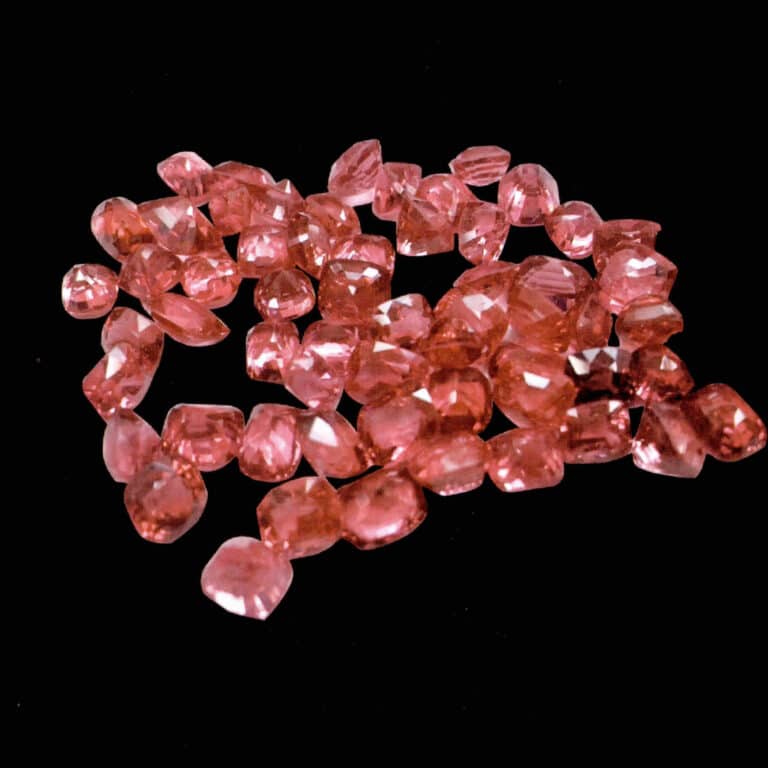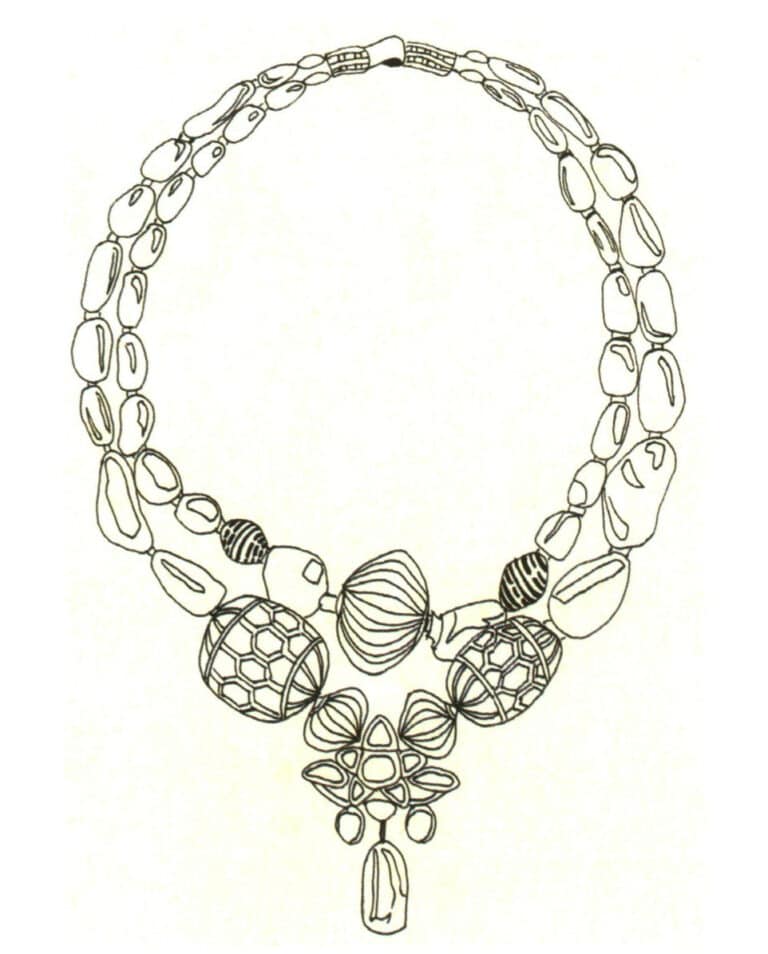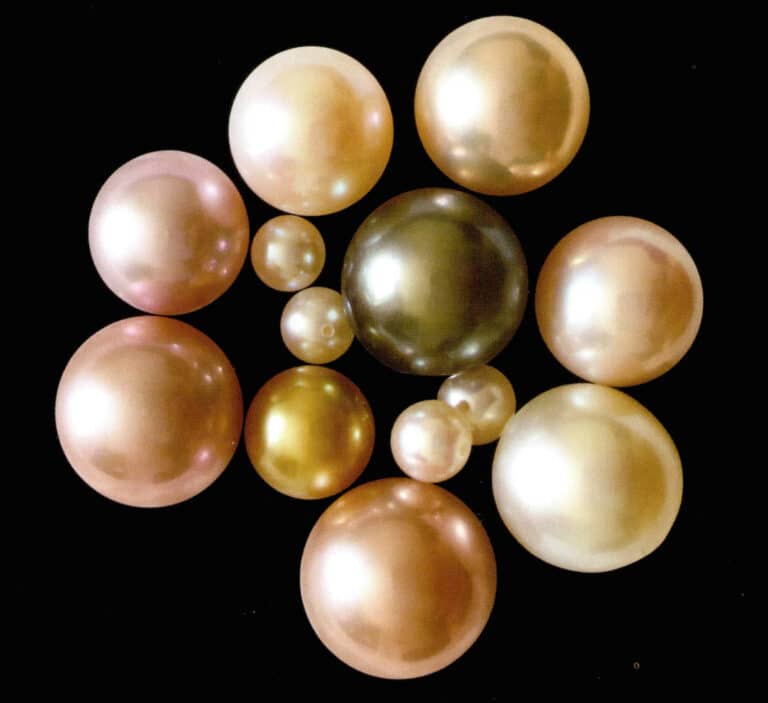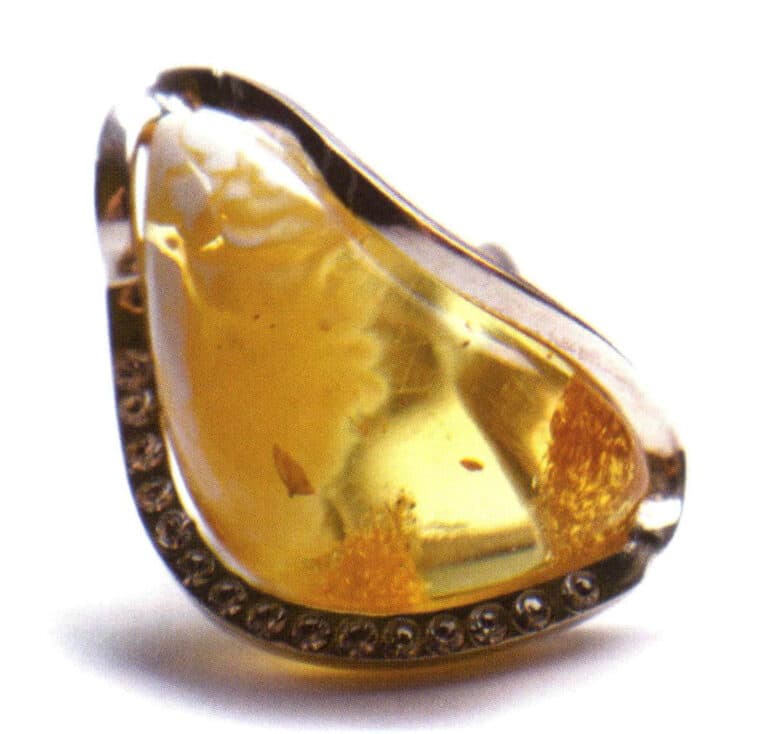Mistä timantit tulevat? Muodostuminen ja maailmanlaajuiset kaivokset opas
Luonnontimanttien hankintaan ja myyntiin liittyvä olennainen tietämys

Australian timantit
Sisällysluettelo
I jakso Timantin muodostumisen geologiset ympäristöolosuhteet
1. Timantin muodostumisen fysikaaliset ja kemialliset olosuhteet
2. Timanttien muodostumisen geologis-rakenteelliset ympäristöt
Luonnosta on löydetty erilaisia timantteja sisältäviä kivilajeja, jotka ovat kaikki mafisia ja ultramafisia kivilajeja. Teollisesti arvokkaita timanttiesiintymiä on kuitenkin vain kimberliiteissä ja lamproiiteissa, jotka molemmat ovat peräisin ultramafisista kivistä, jotka ulottuvat syvälle ylempään vaippaan asti. Geologiset tutkimukset osoittavat, että rakenneympäristöihin, joista timantteja on löydetty maapallolta, kuuluvat pääasiassa vakaissa tektonisissa yksiköissä sijaitsevien kratonien sisäosat, subduktiovyöhykkeet, erittäin korkeapaineiset metamorfiset vyöhykkeet (orogeeniset vyöhykkeet) ja meteoriittitörmäyskraatterit. Kuitenkin vain kratonien sisällä muodostuneet timantit ovat riittävän suuria saavuttaakseen jalokivilaadun; muut timantit ovat kiinnostavia lähinnä teoreettisen tutkimuksen kannalta. Näin ollen geologis-rakenteellisen taustan osalta kimberliittityyppiset primääritimanttiesiintymät, joilla on teollista kaivosarvoa, ovat kaikki syntyneet arkeeisten tektonisesti vakaiden kratonisten yksiköiden sisällä; Luoteis-Australiassa Argylen alueella sijaitseva lamproiittityyppinen primääritimanttiesiintymä esiintyy myös arkeeisten kratonisten reunavyöhykkeiden aktiivisuusvyöhykkeillä ja proterotsooisten kratonien sisällä. Kraatonin muodostumisen jälkeen tarvitaan suhteellisen vakaa ja suljettu geologinen kehitysjakso, joka on otollinen timanttien muodostumiselle ylemmässä vaipassa. Tutkimukset ovat osoittaneet, että kimberliittipitoisia timanttiesiintymiä sisältävillä kratoneilla on seuraavat ominaisuudet.
(1) Ne ovat kehittäneet litosfäärin juuren tai paksuuntuneen litosfäärin, joka ulottuu yleensä noin 200 kilometrin syvyyteen.
(2) Nämä kratonit vakiintuivat ja konsolidoituivat varhain, useimmiten arkeeisen kauden aikana.
(3) Litosfäärin geotermi on alhainen, yleensä <40mW/m.2 sopusoinnussa kilpien normaalin geotermian ja matalien pintalämpövirtausten arvojen kanssa.
(4) Litosfäärin vaipan hapenkulutusaste on suhteellisen alhainen. Koska timantit ovat stabiileja korkeassa paineessa ja suhteellisen alhaisissa lämpötiloissa, jos litosfääri ei ole jollakin alueella riittävän paksu tai hapen hajoamiskapasiteetti on korkea, siellä oleva natiivihiili (C) ei voi muodostaa timantteja, vaan se säilyy grafiittina. Jos geologiselle rakenteelliselle ympäristölle on ominaista tiheät tektoniset liikkeet ja voimakas magmaattinen toiminta, litosfäärin geoterminen gradientti kasvaa, mikä on myös epäsuotuisaa timanttien säilymisen kannalta; ne muuttuvat grafiitiksi tai palavat ja muodostavat CO2 joka pakenee. Tällaiset ankarat tektoniset olosuhteet ovat tärkein syy siihen, että kimberliitit ja timantit ovat levinneet niin harvaan.
Maankohoamisalueiden ja kratonien sisällä olevien notkelmien ja notkoalueiden yhtymäkohdissa olevat taipumisvyöhykkeet sekä maankohoamisalueiden ja notkelmien aksiaaliset osat ovat rakenteellisesti suhteellisen heikkoja vyöhykkeitä, jotka ovat suotuisia kimberliittien ja lamproiittien tunkeutumiselle ja purkautumiselle. Jotta kimberliitti- ja kalimaasälpäiset ultramafiset lamprofiittiputket voivat muodostua ja levitä, on ensin oltava pohjan rikkonaisuuksia tai syviä, ylempään vaippaan leikkautuvia murtumakäytäviä, ja niitä ohjaavat näihin syviin päämurtumiin liittyvät sekundaariset rikkonaisuudet. Kimberliitti- ja lamproiittiputket esiintyvät usein rykelminä ja vyöhykkeinä.
II jakso Timanttien alkuperä
1. Mantelista peräisin olevien sulkeutuneiden kristallien timanttien alkuperä
Mantelista peräisin olevien kiteytyneiden kristallien alkuperää koskevan näkemyksen mukaan timantit muodostuvat syvällä ylemmän vaipan litosfäärin ja asfenosfäärin rajalla, noin 150 ~ 250 km pinnan alapuolella, korkeassa lämpötilassa (1050 ~ 1400 ℃), ultrakorkeassa paineessa, termodynaamisissa olosuhteissa noin 4,5 ~ 6 GPa:n paineessa ja noin 4,5 ~ 6 GPa:n paineessa, vaippaympäristössä, jossa hapen haihtuvuus on alhainen, pelkistämällä CO2, CO,CH4 ja vastaavat. Tärkeimmät todisteet ovat:
(1) Jotkin Etelä-Afrikan, Tansanian, Botswanan ja Siperian kimberliittien peridotiitit, pyrokseniitit, duniitit ja eklogiitit sisältävät timantteja sulkeutuneina faaseina; jotkin harzburgiitti-, lherzoliitti-, duniitti- ja eklogiittiksenoliitit Argylen alueella Luoteis-Australiassa sisältävät myös timantteja, mikä osoittaa, että syvällä ylemmässä vaipassa olevat tietyt tasot isännöivät timanttipitoisia lähdekerroksia.
(2) Primäärisissä kimberliitti- ja lamproittisissa timanttiesiintymissä ja simpukkasijoituksissa kaikkialla maailmassa timanttien sisältämät mineraalisulkeumat ovat olennaisesti samanlaisia ja kuuluvat vaipasta peräisin oleviin kivennäismineraaleihin. Ne voidaan jakaa karkeasti kahteen luokkaan: ensinnäkin peridotiittiryhmän mineraalit, mukaan lukien purppurasarjan pyroppi, kromipinelli, kromidiopsidi, enstatiitti, oliviini, magnesium-ulmeniitti, magnesiowüstiitti, natiivirauta, moissanite ja zirkoni jne.; toiseksi eklogiittiryhmän mineraalit, mukaan lukien oranssin sarjan pyrooppi-almandiinigranaatti, kromispinelli, diopsidi, imfakiitti, ilmeniitti, kyaniitti, rutiili, kesiitti, moosaniitti, korundi jne. Useimmat edellä mainituista sulkeumamineraaleista ovat vanhempia kuin timantin muodostumisikä.
(3) Isotooppisen iän tutkimukset osoittavat, että timanttien muodostumisikä primaariesiintymissä on yleensä paljon vanhempi kuin kimberliitin tai lamproiitin syntyikä, mikä kumoaa pitkään vallinneen käsityksen, jonka mukaan kimberliitti on timanttien emäkivi. Esimerkiksi Etelä-Afrikan Kimberleyn alueella Kimberleyn ja Finschin putkista peräisin olevien timanttien muodostumisikä on 3,3 miljardia vuotta, kun taas kimberliittien syntyajat ovat 90 miljoonaa vuotta ja 120 miljoonaa vuotta. Luoteis-Australiassa Argylen alueella lamproiitissa olevien timanttien muodostumisikä on 1,45 miljardia vuotta, kun taas lamproiitin syntyikä on 110 miljoonaa vuotta. Nämä tulokset osoittavat selvästi, että timanttien muodostumisikä ylemmässä vaipan lähdekerroksessa on paljon varhaisempi kuin timantteja maanpinnalle kuljettavien tärkeimpien isäntäkivien - kimberliitin ja lamproiitin - syntyikä.
(4) Riippumatta siitä, onko kyseessä kimberliitti- vai lamproiittityyppinen primääritimanttiesiintymä, suurimmassa osassa suurista timanteista on merkkejä korroosiosta: litteät kidesärmät, sileät pinnat ja terävät pintakulmat puuttuvat; sen sijaan pinnat turpoavat ja pyöristyvät ja niissä on selviä syövytyspiirteitä. Timanttien pinnanmorfologian muuttuminen viittaa myös siihen, että timantit, jotka olivat jo muodostuneet ylemmässä vaipassa, liukenivat osittain kimberliitti- tai lamproittimagmojen kuljettamina kohti ylempää kuorta ja pintaa.
2. Mantelista peräisin olevan magman kiteytymisen alkuperä
3. Metamorfinen alkuperä
4. Vaikutus Alkuperä
Törmäysperäisen teorian mukaan meteoriitin törmäykset Maahan luovat paikalliset korkean lämpötilan ja erittäin korkean paineen termodynaamiset olosuhteet, jotka voivat muuttaa törmäyksen kohteeksi joutuneissa kivissä olevan hiilipitoisen aineksen timanteiksi.
Yhteenvetona voidaan todeta, että maailmanlaajuisesti löydetyissä taloudellisesti arvokkaissa kimberliitti- ja lamproiittityyppisissä primääritimanttiesiintymissä valtaosa timanteista on vaipasta peräisin olevia ksenokristalleja; vain hyvin pieni osa hyvin muodostuneista pienistä timanttikiteistä on kiteytynyt vaipasta peräisin olevista magmoista.
III jakso Timantteja sisältävät kivilajit
Timantit muodostuivat kauan sitten ylemmässä vaipassa. Kimberliitti- ja lamproiittimagmat ovat vain "kuljettimia" tai "kantajia", jotka siirtävät timantteja syvältä ylemmästä vaipasta ylempään kuoreen ja jopa maanpinnalle, jolloin muodostuvat nykyiset primääriset timanttiesiintymät.
Niistä kimberliitti on tärkein kivilaji. Tähän mennessä on löydetty yli sata kimberliittiputkea, ja sadat niistä ovat timanttia sisältäviä. Siksi timanttiesiintymien etsintä alkaa periaatteessa kimberliitin etsinnällä. Useimmat timanttipitoiset kimberliitit ovat kuitenkin pienialaisia ja harvaan levinneitä; Luoteis-Australiassa sijaitseva Argylen timanttiesiintymä edustaa pääasiassa tämäntyyppistä primääritimanttiesiintymää.
(1) Kimberliitti
Kimberliitti on kalimaasälpäinen ultramafinen kivi, jossa on runsaasti haihtuvia komponentteja (pääasiassa CO2 ja H2O). Vuonna 1870 Kimberleyn alueelta Etelä-Afrikan keskiosasta löydettiin ensimmäisen kerran Dutoispanin kimberliittiputki, joka sisälsi primääritimantteja. Myöhemmin löydettiin kuuluisia timanttia sisältäviä putkia, kuten Kimberley, De Beers ja Bultfontein, ja näin avattiin luku, joka koski kimberliitti- ja primääritimanttiesiintymien tutkimusta.
Maassa paljastunut kimberliitti on yleensä tummanharmaata, harmaata, harmaanmustaa, tummanvihreää tai okranväristä, ja siinä on tyypillisesti porfyriittistä, hienorakeista, pyroklastista tai pseudomorfista rakennetta, jossa on breksioituneita, massiivisia, porfyriittisiä tai tuffimaisia rakenteita. Kimberliitin mineraalikoostumusta hallitsevat oliviini ja flogopiitti, ja siitä puuttuu maasälpä. Se sisältää yleisesti useita indikaattorimineraaleja, kuten timanttia, kromimagnesium-alumiinigranaattia, kromidiopsidia, kromispinelliä, magnetiitti-ilmeniittiä, kalsium-natriummineraaleja, nefeliiniä, rutiilia ja niobium-titaanioksideja. Kiven sisältämiin ksenoliitteihin kuuluu syvältä vaipasta peräisin olevia kiviä ja mineraaleja, kuten oliviinia, pyrokseenia ja diopsidimineraaleja sekä lhertsoliittia ja harzburgiittia. Pinnalla kimberliitti muuttuu helposti serpentinoimalla ja karbonatisoitumalla, joten karbonaatteja ja serpentiiniä esiintyy yleisesti. Säätymisen ja eroosion jälkeen tärkeimmät kiviainesta muodostavat mineraalit - oliviini, pyrokseeni ja mikaalit - muuttuvat sekundäärisiksi mineraaleiksi ja häviävät. Sitä vastoin liitännäismineraalit, kuten granaatti, ilmeniitti, kromiitti, spinelli ja zirkoni, säilyvät, koska ne kestävät hyvin säänkestävyyttä, ja ne toimivat indikaattorimineraaleina sekundääristen timanttiesiintymien löytämisessä.
Tieteellisen tutkimuksen näkökulmasta kimberliitti on yksi luonnon syvimmältä peräisin olevista magmakivistä, joka on peräisin 150-200 kilometrin syvyydestä vaipan litosfäärin alaosasta. Alkuperäiset nesteet ovat saattaneet tulla manttelin siirtymävyöhykkeeltä, ja ne kuljettavat usein mukanaan manttelin peridotiittia ja alemman maankuoren kivilajin ksenoliitteja, jotka säilyttävät suuren määrän tietoja syvällä sijaitsevan materiaalin koostumuksesta ja geologisista prosesseista. Ne voivat antaa tietoa kivilajeista, mineraalikoostumuksesta, geokemiallisista ominaisuuksista, lämpötilasta ja jännitystilasta noin 200 kilometrin syvyyteen asti, mikä tekee niistä tärkeän ikkunan maapallon sisimmän osan tutkimiseen. Taloudellisen arvon kannalta kimberliitti on erittäin läheisessä yhteydessä timantteihin, jotka ovat arvokkaita jalokivivaroja, ja se on timanttien tärkein isäntäkivi. Valtaosa maailman jalokivilaatuisista timanteista tuotetaan kimberliitistä. Esimerkiksi maailman suurin Cullinan-timantti (3 106 ct) tuotettiin Premier-kimberliittiputkesta Transvaalissa Etelä-Afrikassa.
(2) Lamproite
Lamproiitti on ultrapotassi-magnesium- tai ultramafinen, hyvin matalaintruusiivinen tai vulkaaninen kivi. Lamproiitin muodostavat mineraalit ovat pääasiassa joitakin K- ja Ti-rikkaita mineraaleja. Sen lisäksi, että se sisältää oliviinia (fenokiteitä ja mikrofenokiteitä) ja flogopiittia (fenokiteitä ja pohjamassaa), se voi sisältää myös kalium-alkalimagnesia-amfibolia ja andradiittia, diopsidia; liitännäismineraalien tyypit ovat monitahoisia, mutta niitä hallitsevat Ti-mineraalit, ja se sisältää myös kromiittia, granaattia ja sulfideja. Kimberliittiin verrattuna lamproiitissa on enemmän SiO2 (40%); ja MgO-, K2O-pitoisuudet ovat korkeammat kuin tavallisissa mafisissa kivilajeissa, kun taas alumiinin ja alumiinin pitoisuudet ovat korkeammat kuin tavallisissa mafisissa kivissä.2O3 is low, making it a peralkaline rock type.
Kimberlite and lamproite weather very easily. Kimberlite and lamproite that contain diamonds, after weathering and erosion, are transported by surface water and other geological processes to rivers or coastal areas, and are deposited in suitable locations in the middle and lower reaches of rivers or along coasts, thus forming secondary diamond alluvial deposits. Alluvial deposits are the world’s primary source of diamond resources (Fig. 2-1). Many famous diamonds in the world, such as the Koh-i-Noor and the Great Mogul, originate from alluvial deposits; early human diamond exploitation also mainly sourced diamonds from alluvial deposits.

Section IV Sorting of Diamonds
The grade of primary diamond ore is generally low; ore containing more than one carat per ton has mining value. Therefore, during diamond mining, the extracted ore must be processed for ore concentration.
The diamond beneficiation process generally includes several stages: preparation, coarse concentration, and fine separation.
1. Preparation Stage
The preparatory work before diamond beneficiation typically includes crushing, screening, washing, grinding, and hydraulic classification. The main purpose is to prepare for the beneficiation work and to achieve good results.
(1) Crushing. The primary purpose is to disintegrate coarse ore particles fully; during the crushing process, special attention must be paid to minimizing breakage of diamond crystals.
(2) Screening. Screen out ore of suitable particle size to avoid excessive crushing of the ore, reduce energy consumption, improve production efficiency, and promptly and effectively protect diamond crystals to prevent diamond breakage.
(3) Washing. This is the process of removing clayey material from the ore; it functions to disperse the clay and separate clay substances from granular material.
(4) Grinding. The washed granular material is abraded in mechanical equipment to further reduce the ore particle size. Its main purpose is to liberate all or most of the fine diamond particles from the ore as individual units so they can be effectively recovered in the next concentration process.
(5) Hydraulic classification. Further subdivide the particle sizes of the material; its principle is based on differences in particle size (or density) and the resulting differences in settling velocity in a fluid.
2. Coarse Concentration Stage
The main task of coarse concentration is to achieve preliminary enrichment. Diamond has a specific gravity of 3.52, while other minerals that coexist with diamond generally have specific gravities less than 3. By separating a small amount of heavy minerals that contain diamonds from a large amount of light gangue minerals that do not contain diamonds, the end product is a coarse concentrate containing diamonds. The commonly used methods for coarse concentration are three: washing (sluicing) concentration, jigger (pulsator) concentration, and heavy-medium separation.
(1) Washing (sluicing) concentration. Its basic principle is separation based on differences in mineral density. Because diamond has a relatively high density, it and other small amounts of high-density heavy minerals concentrate in the bottom flow of the sluice, while low-density gangue minerals are discharged over the overflow weir, thus achieving separation according to density differences.
(2) Jigger (pulsator) concentration. Its basic principle is that, based on differences in density, shape, surface friction coefficient, etc., between diamond and gangue, materials stratify by density in a vertically alternating flow medium. Because diamonds have a relatively large density, are usually rounded in shape, and have smooth surfaces, they have higher settling velocities and a greater ability to penetrate layers, making them easy to enrich and form concentrates.
(3) Heavy-medium separation. Its basic principle is based on Archimedes’ principle: the force experienced by an object in a liquid is proportional to the volume of the liquid and the density difference between the mineral particles and the medium; mineral particles with a density greater than that of the separating medium will sink in the medium and accumulate at the bottom of the separator; mineral particles with a density less than that of the medium will float on the upper layer of the medium and accumulate at the surface of the separator. By discharging the two types of mineral particles separately from the separator, products of different densities can be obtained.
3. Find Separation Stage
Common methods for selecting diamonds include: grease table concentration, surface flotation, and X-ray photoelectric sorting.
(1) Grease table concentration. The grease method is mainly a diamond beneficiation technique developed based on diamonds’ oleophilic and hydrophobic properties. The process involves putting the prepared diamond-bearing material onto the sticky grease surface of a grease table; the oleophilic (hydrophobic) diamonds adhere to the grease surface and become concentrated as the concentrate, while the oil-repellent gangue does not stick to the grease surface and is washed away by water as tailings, thus achieving separation.
(2) Surface flotation. This is also a diamond beneficiation method developed based on diamonds’ oleophilic and hydrophobic properties. Unlike the grease method, surface flotation relies on the surface tension of water to cause hydrophobic particles to float on the water surface. In contrast, hydrophilic particles sink into the water, thereby achieving separation.
(3) X-ray photoelectric sorting. Because diamonds can fluoresce under X-ray irradiation with relatively high luminescence efficiency, while most other minerals do not fluoresce or emit spectra different from diamonds, this characteristic can be used for diamond sorting. Therefore, industrial use of X-ray sorters for diamond picking started relatively early; this method was already being used in the 1930s to pick diamonds. The advantages of using X-rays to sort diamond-bearing ore include a very high recovery rate, reaching 98%~100%, and the sorting machines have high processing capacity, high sorting efficiency, and low production cost. In the 0s of the 20th century, many countries had already applied X-ray sorting industrially to diamond ore. With the progress and popularization of electronic technology, diamond X-ray sorting has been widely used and has developed rapidly.
Section V Distribution of the World's Diamond Resources
According to statistical data, there are currently 27 countries in the world that produce diamonds. Of these, 18 are in Africa: South Africa, Botswana, Namibia, Angola, Lesotho, Zimbabwe, Eswatini, Tanzania, Zambia, Democratic Republic of the Congo [Congo (Kinshasa)], Republic of the Congo [Congo (Brazzaville)], Côte d’Ivoire, Central African Republic, Gabon, Ghana, Sierra Leone, Liberia, Guinea; Asia has 3: China, India, Indonesia; Europe has 1: Russia; Oceania has 1: Australia; South America has 3: Brazil, Venezuela, Guyana; North America has 1: Canada.
Among them, Russia, Botswana, Zimbabwe, Canada, Australia, the Democratic Republic of the Congo, Angola, and South Africa have been the world’s main diamond-producing countries in recent years. The combined annual diamond production of these eight countries accounts for more than 95% of the world’s total production.
(1) Russia’s Diamond Resources
Russia is a world-renowned diamond-rich country; diamond mining began in 1829. At that time, a German mineralogist working at a mine in the Ural region identified a 0.5 ct diamond that a 14-year-old Russian boy, Paul Poppff, had found while panning for gold, but these early discoveries had no real commercial significance. According to records, from 1937, there was a planned, organized survey of diamond resources in the Urals, which led to major discoveries. In 1941, diamond placer mining began in the Urals. In 1948, geologist C. H. Sokolov discovered the first diamond in the Yakutia region of central Siberia in the basin of the Maly Anyuy River. In August 1949, Γ. X. Feinshtein discovered the first Yakutsk diamond-bearing placers of industrial value in the basin of the Sokolinnaya Luy River. In 1954, geologist Л. А. Погудайева was the first to discover kimberlite primary diamond deposits in the Yakutia region.
Russia’s diamond resources are mainly distributed in the Sakha (Yakut) Republic of Siberia, and in Arkhangelsk and Perm oblasts.
Since the discovery of the first kimberlite pipe with diamonds in the Sakha (Yakut) Republic in 1954, 120 kimberlite pipes were discovered in the following five years, the most famous being the “Mir” and “Udachnaya” pipes. Currently, the region has about 500 kimberlite pipes, 10% of which contain diamonds. The diamond resources are mainly primary kimberlite-type deposits, which are the principal source of Russia’s diamonds.
The Russian currently operates the diamond resources of the Sakha (Yakut) Republic–Sakha Diamonds Joint Stock Company (referred to as “ALROSA”). At present, ALROSA’s diamond exports account for 95% of Russia’s exports and 25% of the global market (by carat). In 2014, diamond production was 36.2 million carats. Proven reserves reach 600 million carats, about one-third of the world’s total, 65% of which are gem-quality or near-gem-quality and can support continuous mining for 30 years.
ALROSA has four main mining areas in West Yakutia: Mirny, Udachny, Aikhal, and Nyurba. The “Mir” mine in the Mirny district was the first kimberlite-type primary diamond deposit discovered in Russia. It is also the world’s deepest open-pit diamond mine; mining began there in 1957 with an average annual output of 2 million carats, creating a huge pit 525 m deep and about 1.2 km in diameter. Due to resource depletion, open-pit mining at the mine ceased in 2001. In 2009, the Mir mine transitioned to underground mining with an annual capacity to process 1 million tonnes of ore and an expected life of 34 years. The “International” mine, located 15 km southwest of Mirny, was discovered in 1969 and began open-pit mining in 1971; by 1980, the pit had already reached a depth of 284 m and was later closed, while underground mine construction had already started in the mid-1970s. Underground mining began in 1999 with a designed annual ore processing capacity of 500,000 tonnes and an expected life of 27 years. On April 16, 2019, a large diamond weighing 118.91 ct was recovered from this mine and named the Zarya diamond (Figure 2-2).

The “Success” mine in the Udachny district is even larger and is Russia’s largest diamond deposit, with reserves of about 120 million carats. Mining began in 1971, and it is also one of the world’s largest diamond mines. Its open pit has reached a depth of 640 m, and surface mining is nearing its end. Construction of its underground mine began in 2004, and it has now been completed and put into production. In 2019, it achieved full-capacity operation. The underground mine’s production capacity will reach 4 million tonnes of ore, making it one of the largest underground mines in the world.
The Aikhal district has three mines. The “Aikhal” mine began open-pit mining in 1961; after reaching a depth of 230 m in 1997, open-pit operations ceased, and underground mining trials began. In 2008, phase one of the underground mine was completed, with a production capacity of 150,000 tonnes of ore; phase two was completed in 2013, bringing capacity to 500,000 tonnes. The “Jubileynaya” mine was discovered in 1975 and is still being mined as an open pit; its original design depth was 500 m, but a recent expansion plan has been approved to extend open-pit mining to a depth of 700 m. The “Komsomolskaya” mine was discovered in 1970, but development did not begin until 2001, and open-pit mining will reach a depth of 460 m.
Nyurba is the most recently developed district, discovered only in the 1990s. The Botuobinskaya mine was discovered earliest among them, but did not begin production until 2015; in December 2019, it yielded a large diamond weighing 190.77 ct (Fig. 2–3). The later-discovered Nyurba mine began open-pit mining in the early 21st century and is currently mined to a depth of 300 m.

Primary kimberlite deposits also dominate the diamond resources of Arkhangelsk Oblast. In 1979, geologists discovered a series of diamond-bearing kimberlites in the Winter Coast area in the northeast of Arkhangelsk Oblast; among these, the M. V. Lomonosov and V. Grib deposits are the two most important. The Lomonosov deposit is located in the western Zolotitsa area and contains six separate pipes within a 9.5 km north–south span: Karpinsky-1, Karpinsky-2, Pionerskii, Lomonosov, Pomorskii and Arkhangelskii. The diamond grade is 0.5~1.0ct/t; it is a new diamond district in Russia. Production construction began in September 2013, with an effective mining life of about 50 years and projected diamond output of up to 200 million carats. The Grib deposit is located in the eastern Verkhotina–Soyana area, i.e., the Grib pipe, with a diamond grade of; its output is more than twice that of any pipe of the Lomonosov deposit, and the diamonds are of high quality. Proven reserves amount to 98 million carats, making the deposit the fourth-largest in Russia after the Sukhoi, Jubilee, and Mir mines, and it may become a new source of growth for Russian diamond production.
Perm Oblast mainly has diamond placer deposits; this mine is located in the Ural region, where diamonds were first discovered within Russia. Its output is low, accounting for about 2% of Russia’s total diamond production.
From 2006 to 2013, Russia’s total production of gem-quality and industrial diamonds remained the highest in the world, while total value ranked second globally. The vast majority of diamonds are produced from kimberlite pipes, with a small proportion from alluvial placer deposits. Russia’s diamond production value has been relatively stable for many years; total production peaked in 2006 and began to decline slightly from 2008, mainly due to the impact of the global financial crisis and the resulting drop in diamond consumption demand.
(2) Diamond Resources of Botswana
Diamond mining in Botswana began more than 100 years ago, and true large-scale exploration started in 1965; to date, more than 200 kimberlite pipes have been discovered. In 1967, the Orapa pipe, the world’s second-largest kimberlite pipe, was discovered, and in 1972, the world’s largest gem-quality diamond mine, the Jwaneng pipe, was discovered. The pipes that have been mined include the Orapa pipe, the Jwaneng pipe, the Letlhakane DK1, DK2 pipes, and the newly developed Karowe mining area. Botswana’s total diamond output ranks among the top two in the world, and its production value has remained among the top three globally. Affected by economic factors such as the global financial crisis, from 2009, Botswana’s diamond production experienced a noticeable decline, falling from about 30 million carats per year to about 20 million carats per year.
Among them, the Jwaneng diamond mine is the richest in the world and has a relatively high grade. The Orapa mine is the world’s second-largest producing kimberlite pipe, with high annual capacity, producing 1.11 million carats of diamonds.
The Orapa pipe has proven reserves of more than 100 million carats, with an average grade of 0.6ct/t, medium-quality; gem-quality diamonds account for 15%. Since mining began in 1972, the pipe has yielded about 75 million carats of diamonds, including an annual output of 733,000 carats in 1992. Annual production in 2013 was 1.11 million carats. The Jwaneng pipe has proven diamond reserves of about 200 million carats, with an average grade of 1.5ct/t, relatively good quality, with gem-quality diamonds reaching 80%, mainly colorless and transparent, and also producing a considerable number of green diamonds. Crystal forms are complete, mostly octahedral and dodecahedral; from 1978 to 1992, about 92 million carats were produced, with an annual output of 12.7 million carats in 1997. In recent years, annual production has been 1.0~1.1million carats, making it the world’s most profitable diamond mine. The Letlhakane DK1, DK2 pipes have proven reserves of 20 million carats, with an average grade of 2.5ct/t, gem-quality diamonds accounting for 15%, since 1988, the average annual diamond production has been 600,000~950,000 carats.
The Karowe open-pit diamond mine is owned by Canadian company Lucara and is located in central Botswana; it was completed and put into production in 2012. Since 2012, about 2.5 million tonnes of ore have been mined each year from three kimberlite pipes, producing an average of 300,000~320,000 carats of diamonds per year. The mine has reserves of 57.85 million carats, with approximately 7.9 million carats of recoverable diamonds remaining. In recent years, the mine has repeatedly yielded large diamonds (Table 2-1, Figures 2-4 to 2-9) and extra-large diamonds.
Table 2-1 Overview of large diamonds discovered at the Karowe diamond mine in recent years
| Ei. | Discovery Time | Weight /ct | Remarks |
|---|---|---|---|
| 1 | July 2015 | 269 | Figure 2-4 |
| 2 | November 2015 | 316 | Figure 2-5 |
| 3 | April 2016 | 119 | Figure 2-6 |
| 4 | November 2016 | 336 | Figure 2-7 |
| 5 | June 2018 | 327.48 | Figure 2-8 |
| 6 | September 2019 | 123 | Figure 2-9 |

Figure 2-4 Rough diamond (269 ct)

Figure 2-5 Rough diamond (316 ct)

Figure 2-6 Rough diamond (119 ct)

Figure 2-7 Rough diamond (336 ct)

Figure 2-8 Rough diamond (327.48 ct)
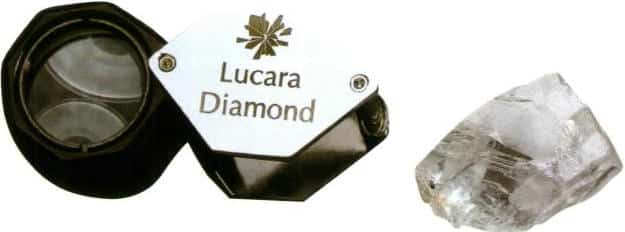
Figure 2-9 Rough diamond (123 ct)
Copywrite @ Sobling.Jewelry - Custom korujen valmistaja, OEM ja ODM korut tehdas
(3) Diamond Resources of Zimbabwe
Zimbabwe has gradually become an important international diamond-producing country in recent years (Fig. 2-10). Production jumped from 960,000 carats to 8.44 million carats in 2010 and has continued to grow year by year. In 2012, Zimbabwe’s total diamond production reached 12 million carats, ranking fourth in the world, with a production value of $640 million, ranking seventh. In 2013, Zimbabwe’s diamond production was 10 million carats, with production declining in recent years.
Zimbabwe’s main diamond deposits are the Murowa and Marange fields. The Murowa field is located in south-central Zimbabwe, adjacent to Zvishavane, and includes three kimberlite pipes; it is the only diamond field in Zimbabwe with commercial value. Production in 2012 reached 3.67 million carats.
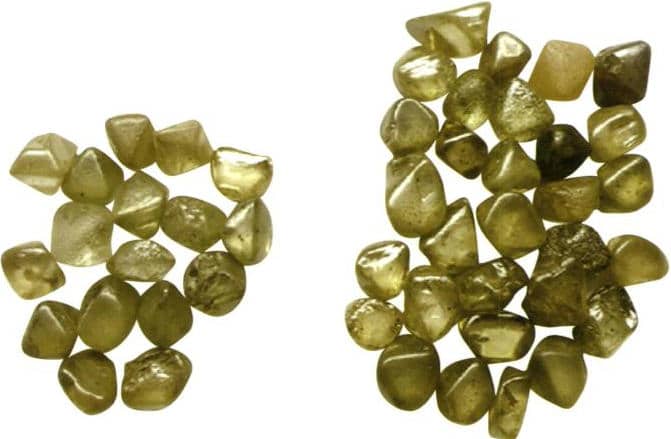
(4) Canada’s Diamond Resources
Canada’s diamond exploration underwent a long and winding process. As early as 1899, Canadian geologist W. N. Hobbs had pointed out that primary diamond deposits might exist within Canada. Subsequently, despite extensive exploration, no breakthrough was made until 1991, when a large kimberlite-type primary diamond deposit was discovered in the Sverdrup region of northern Canada, marking a breakthrough. The average grade of the diamond-bearing kimberlite pipes is 1.25~5ct/t; the diamonds are mainly colorless and transparent, with relatively good quality, and gem-quality diamonds account for 25%~40%. Because the diamond resource reserves are considerable and mining has continued, Canada has become one of the most important diamond-producing countries in the past decade. From 2010, it ranked fourth in the world in production for three consecutive years and third in value, and rough stones, at an average price of about US$200/ct, rank first among major diamond-producing countries. Between 1960 and 1998, more than 500 kimberlite pipes were discovered in Canada; 90% of them were discovered in the 1990s, and among them, half of the kimberlite pipes contain diamonds, far exceeding the world average. In 2013, Canada’s total diamond production was about 10 million carats, with a value as high as US$1.9 billion, accounting for 13.48% of the world’s total value.
Currently, the diamond mines being mined in Canada are mainly two: the Diavik mine and the Ekati mine (Fig. 2-11). In August 2015, a large yellow diamond weighing 187.70 ct was found at the Diavik mine and named the Foxfire diamond (Fig. 2-12). In October 2018, a yellow extra-large diamond weighing 552.74 ct was found at the same mine; the diamond is 33.74 mm long and 54.56 mm wide, and it is the largest diamond discovered in North America to date.

Figure 2-11 Canada's Diamonds

Figure 2-12 Foxfire Diamond
(5) Australia’s Diamond Resources
The earliest discovery of diamonds in Australia was in 1851, near the Macquarie River, close to Bathurst in New South Wales. Later, some small alluvial diamond deposits associated with gold were found in Queensland. In the 1970s, a large olivine potassium-magnesium lamproite primary diamond deposit was discovered in the Argyle region of northwestern Australia, propelling Australia to become one of the world’s major diamond-producing countries (Fig. 2−13).

Australia’s diamond production peaked in 2006; however, as the Argyle mine shifted from open-pit to underground mining, its output began to decline sharply, falling from 30 million carats in 2006 to 9 million carats in 2014, and its total production ranking dropped from third in the world at the end of the twentieth century to sixth.
Australia has three diamond fields in total. Argyle is Australia’s largest diamond field; almost all of Australia’s diamonds come from the Argyle mine. Argyle’s production in 2011 was 7.4 million carats, accounting for about 90% of Australia’s total production. The mine has very high diamond grades: open-pit of 3.1ct/t, underground of 3.7ct/t. The diamonds produced are relatively small, mostly brown, and irregular in shape. However, it contains a certain number of vividly colored pink and rose gem-quality diamonds. Nearly 90% of the world’s pink diamonds come from Argyle, which has drawn international attention to pink diamonds and colored diamonds in general. Argyle’s underground mine began full production in April 2013, reached an annual output of 20 million carats in 2014, and 30 million carats in 2016.
The Merlin diamond mine is located in the northern part of the Northern Territory of Australia. The deposit was discovered in 1994 and put into production in 1999. It is Australia’s second-largest operating diamond mine; the deposit consists of 12 small kimberlite pipes. It operated for four years from 2000 to 2003, producing about 500,000 carats of high-quality diamonds. The proportion of gem-quality diamonds in the Merlin mine is very high, reaching 65%.
The Ellendale mine was discovered in November 1976. In the following years, it was determined that 38 of 46 pipes contained diamonds. The highest-grade pipes were Nos. 4 and 9, with an average grade of 0.14ct/t; the diamonds are of good quality, with gem-grade stones accounting for 60%, and they also include a certain proportion of pink and rose-colored gem diamonds.
Most Australian diamond production comes from primary deposits. The diamonds produced are relatively small, and to date, no rough diamond larger than 100 ct has been found. Most notable is that the diamonds include a certain number of vividly colored pink and rose gem diamonds, which are extremely rare treasures.
(6) Diamond Resources of the Democratic Republic of the Congo
The Democratic Republic of the Congo [abbreviated D.R. Congo] used to be one of the world’s major diamond-producing countries. In recent years, due to many political and other problems facing the country, diamond production has fluctuated greatly. The country’s diamond resources are mainly distributed in the Bushimaie area of East Kasai Province and the Tshikapa area of West Kasai Province. Diamonds were first discovered in the D.R. Congo in 1907, when a 0.1 ct diamond was accidentally found during a survey of gold deposits in the Kasai River basin in the Tshikapa area. Afterwards, many diamond alluvial deposits were found using methods similar to gold panning. A real breakthrough in diamond exploration came in 1946, when a group of kimberlite pipes rich in diamonds was discovered near Bushimaie in East Kasai Province. In 1955, another group of diamond-rich kimberlite pipes was found at Kiba, 30 km southwest of Bushimaie, greatly increasing the D.R. Congo’s diamond output and propelling it to become a major diamond-producing country. According to reports, in the Bushimaie area’s primary deposits, gem-grade diamonds account for 3%, while in the Tshikapa area’s alluvial deposits, gem-grade diamonds account for 65%. Between 2006 and 2013, D.R. Congo’s diamond production was very large, ranking among the world’s top three. Still, because the proportion of gem-grade diamonds was low, the value per carat was low, so its total production value ranking was not high.
(7) Angola’s Diamond Resources
Angola is one of the world’s most important diamond-rich countries, with both alluvial and primary diamond deposits. In 1912, diamond alluvium was first discovered in the northern Londa region, with the proportion of gem-quality diamonds exceeding 70%. After more than 40 years of exploration work, kimberlite-type primary diamond deposits were finally found in the Londa region. About 700 kimberlite pipes have been discovered, of which at least 300 contain diamonds; 5–10 kimberlite pipes have economic value. The Catoca kimberlite pipe, which is already in production, has an annual output of about 6 million carats. Ninety-four diamond-bearing kimberlite pipes are known, three of which have significant economic value, including the famous “Camuti” large primary diamond deposit. Diamonds produced in Angola are of high quality, second only to those from Namibia, characterized mainly by colorlessness and high clarity. The Lulo diamond mine produced a large 227 ct diamond in 2017 (Fig. 2-14).

(8) South Africa’s Diamond Resources
South Africa’s first diamond was found in 1866 on the banks of the Orange River; the diamond weighed 21 ct. It was the first diamond discovered on the African continent and was later cut and polished into a 10.73 ct gem named “Eureka” (Figure 2-15). This diamond, which has special historical significance, after passing through many hands over a century, was bought back by De Beers and returned to its “homeland” in 1967; it is now preserved in the Kimberley Mine Museum in South Africa.

In 1870, the first primary kimberlite diamond deposits were discovered in South Africa, marking the first major breakthrough in the history of diamond prospecting worldwide. Several famous diamond mines were subsequently found, such as Jagersfontein, Dorstfontein, Bultfontein, and Koffyfontein; in 1871, the De Beers and Kimberley mines were discovered; in 1890, the Wesselton mine was discovered; in 1902 the famed Premier mine was discovered — it is South Africa’s largest diamond mine, and the famous “Cullinan” diamond was found there in 1905; in 1960 the Finsch mine was discovered; in 1987 the Venetia mine was discovered. Among these, the Venetia mine is currently South Africa’s largest diamond-producing district, composed of 11 pipes; this district has entered underground mining, with estimated reserves of about 96 million carats and a planned operating life of 30 years.
Since diamonds were discovered and mined in South Africa in the late nineteenth century, the country has been the world’s most important diamond producer. Before 1910, its production accounted for more than 95% of the world’s output; with continued mining, resources gradually became depleted and production declined. A notable characteristic of South African production is the relatively large number of large diamonds. Overall, the diamonds from South Africa are of good quality and large size, 35% are gem-grade, and 23% are near-gem grade. It has also produced some high-quality diamonds that are light bluish-white, light blue, or blue in color. In 2012, its production ranked seventh, and in 2013, it ranked eighth.
(9) Diamond Resources of other Countries
The eight countries above are the world’s main diamond-producing nations, with their diamond output accounting for approximately 95% of the world’s total diamond production. In addition, there are some other countries in the world that also produce diamonds.
① Namibia. Diamonds from Namibia are mainly recovered from coastal alluvial sand deposits. Diamonds were first discovered in 1908 near Lüderitz on Namibia’s Atlantic coast. These coastal alluvial deposits extend intermittently for about 96 km north of the Orange River mouth, making them the world’s largest coastal diamond sand deposits. Namibia’s diamond production is not very large in quantity. Still, it has long been renowned for the exceptionally high quality of its diamonds and a very high proportion of gem-grade stones. The diamonds produced are of excellent quality, mainly colorless and clean, with a small quantity of rare pale bluish-white diamonds; gem-grade diamonds account for more than 80%. No primary diamond deposits have been found in Namibia to date. Currently, the proven diamond ore reserves total 59.4 million tonnes.
② Sierra Leone. Sierra Leone’s diamonds were first discovered in 1930 by geologist J. D. Pollet in gravel deposits, after which large-scale prospecting was carried out in the gravels of the Sewa River basin, diamonds were also found in the strata. Therefore, Sierra Leone is also one of the world’s important diamond-producing countries. Its highest historical diamond production was 2.05 million carats in 1970, and estimated reserves are 20 million carats. The diamonds produced are generally of good quality; gem-grade diamonds account for more than 60%, mainly high-clarity, white, top-quality gem diamonds, and large diamonds are often produced. Many diamonds are octahedral in form with bright crystal faces, and occasionally diamond crystals larger than 100 ct or more can be found. In 1945, the 770 ct “Woyie River” diamond was discovered, and in 1972, the 968.90 ct “Star of Sierra Leone” diamond was found.
③ Tanzania. Tanzania’s diamond mines are mainly located in the Mwanza region on the southern shore of Lake Victoria. In 1934, Dr. John Williamson of the Quebec Geological Survey, of Irish descent, arrived in the Mwanza area. Based on his research, he believed Tanzania had primary diamond deposits; after persistent efforts, he finally found a primary kimberlite pipe in the Mwadui area. The pipe is elliptical, with major and minor axes of 1,525 m and 1,068 m respectively, covering an area of 1.46 million square meters—currently the largest kimberlite pipe discovered in the world. The pipe has a relatively low diamond grade, containing about 10–20 ct of diamonds per 100 t of ore, but the diamonds produced are of good quality, with gem-grade diamonds accounting for 51%, and proven reserves exceeding 50 million carats. In the 1950s~1960s, the mine produced more than one million carats of diamonds annually. With increasing mining depth, diamond output declined year by year, and current annual production is about 100,000 carats. Having been mined for over 50 years, estimated reserves are no more than 10 million carats. Diamonds from the Mwadui mine are generally colorless and transparent, and some small green and pink diamonds are also produced.
④ India. India was historically the earliest country to produce gem-quality diamonds and was once a major source of the world’s diamonds. Later, with the successive discoveries of diamond deposits in Brazil and the African continent, India’s position as a diamond producer greatly declined. Many famous historical diamonds, such as the Koh-i-Noor, the Darya-i-Noor, and the Hope Diamond, were all produced in India; these diamonds were all mined from alluvial deposits, mainly from the Godavari and Krishna rivers near Hyderabad. These mining areas are now exhausted. In 1925, primary and alluvial diamond resources were discovered in the Panna region of India. In recent years, annual diamond production has been about 30,000~50,000 carats, but the diamond quality is very good, with gem-grade diamonds accounting for over 85%, characterized by colorless transparency and high clarity; India also produces rare green gem-quality diamonds. Current estimated reserves are 10 million carats.
⑤ Brazil. Diamonds from Brazil once held an important place in history. The discovery of diamonds in Brazil was closely linked to gold prospecting; early gold panners often found some shiny pebbles at the bottom of their pans. They kept the larger ones and discarded the smaller ones—those shiny pebbles were actually diamonds, but at that time, people had not yet recognized them.
It is generally believed that Brazil’s diamonds were first discovered in 1725, but who discovered them first is disputed: some say it was a priest, others believe it was the indigenous people of Minas Gerais, but one thing is certain — these people had definitely seen diamonds in India. Diamonds are widely distributed in Brazil, occurring in Minas Gerais, Goiás, Amazonas, Maranhão, Paraná, Piauí (Piauí, and São Paulo.
The diamonds produced in Brazil are generally small in size but of good quality; occasionally, large diamonds have been found, such as the “President Vargas” diamond, the “Goyas” diamond, and the “Darcy Vargas” diamond, all mined from alluvial deposits. Brazil was once one of the world’s major diamond-producing countries.
(10) China’s Diamond Resources
China has a long history of diamond exploration and use, recorded in some ancient books. For example, Jin Qiju Zhu records: “In the third year of Xianning (AD 277) Dunhuang sent diamonds; in gold, after a hundred washings, they do not dissolve, they can be carved like jade, originating from Tianzhu.” The Classic of Mountains and Seas, West Mountain Classic says: “Now outside the border comes diamond, the stone resembles gold, has luster, can be carved like jade.” A gold ring set with a diamond was found among artifacts unearthed from an Eastern Jin tomb at Xiangshan, Nanjing, dating to the 4th century AD; the diamond’s diameter is about 1 mm, and the ring’s diameter is 2.2 cm. This is the earliest diamond artifact found in China to date. It was not until the 1950s that China really began large-scale exploration and development of diamonds. In the late 1950s, an alluvial diamond deposit of industrial value was first discovered in the Yuan River basin in Hunan; in the mid-1960s, a kimberlite-type primary diamond deposit was found in Mengyin, Shandong; and from the 1970s to the early 1980s, a large, high-grade, good-quality primary diamond deposit was found at Wafangdian, Liaoning — currently China’s largest. China’s proven primary diamond reserves now rank about 10th in the world, mainly distributed in Shandong, Liaoning, and Hunan; additionally, Guizhou and Jiangsu have small outputs. Proven reserves now exceed 25 million carats, and current annual production is 15~20 thousand carats.
① Diamond resources in Hunan. Changde and Taoyuan in Hunan are famous diamond alluvial deposit areas in China. Diamonds are mainly distributed in the alluvium of the Yuan River basin. The diamonds produced have complete crystal forms, mainly octahedra and rhombic dodecahedra. The vast majority are light in color, have good transparency— mainly light yellow and colorless transparent—and high clarity. The diamond quality is good, but the grade is low; gem-grade diamonds account for 60%~80% of the total diamonds produced.
② Diamond resources in Shandong. The Yimeng Mountain area in Shandong is an important diamond-producing region in China and was also the earliest area where kimberlite-type primary diamond deposits were discovered in the country. The primary ore bodies occur as three kimberlite belts (Changma, Xiyu, Poli), mainly distributed within Mengyin County. The primary diamond ore bodies with industrial mining value are concentrated in the Changma and Xiyu belts of Mengyin County. Kimberlite bodies with large-scale industrial mining value are mainly the Hongqi No. 1 dyke and Shengli No. 1 pipe in the Changma belt, the Hongqi Nos. 6, 22, and 28 pipes in the Xiyu belt, as well as those in the Poli belt. Among them, the Shengli No. 1 pipe has been converted to underground mining and is currently the only diamond mine being mined on a large scale.
The diamonds produced from the Shengli No. 1 pipe vary greatly in size. On November 14, 1983, miners hand-extracted a large 119.06 ct diamond (Mengshan No. 1) from the run-of-mine before coarse crushing; together with two small residual fragments left on the host rock, the total weight was 120.65 ct. In 2003, large diamonds of 27.09 ct, 52.79 ct, 23.40 ct, 33.30 ct, and 28.00 ct were subsequently selected. On May 27, 2006, a 101.4695 ct elongated octahedral Ia type large diamond was picked from a conveyor belt, called Mengshan No. 5 (Fig. 2-16); this was also the first diamond over 100 ct obtained during beneficiation processes in China. The diamonds from the Shengli No. 1 pipe are mainly single crystals and polycrystals, with very few twinned crystals. Crystal forms are dominated by rhombic dodecahedra and curved-faced rhombic dodecahedra, followed by octahedra and aggregates of curved-faced rhombic dodecahedra.
Shandong diamonds are mostly pale yellow and colorless, followed by light brown and light gray; pale blue, green, and red tints can occasionally be seen. Gem-quality diamonds account for approximately 10%~15% of the total. In addition, small alluvial diamond deposits are distributed in the Yishui River basin in the Tancheng area. Shandong is also a major source of large diamonds in China; the five diamonds over 100 ct discovered in China to date all come from Shandong, for example: the Jinji Diamond (weighing 281.57 ct), the Changlin Diamond (weighing 158.786 ct, Fig. 2–17), Chenbu No. 1 (weighing 124.27 ct), Mengshan No. 1 Diamond (weighing 119.06 ct), and Mengshan No. 5.
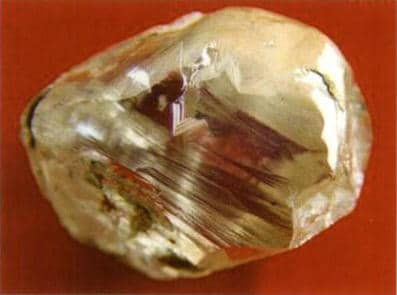
Figure 2–16 Mengshan No. 5 Diamond
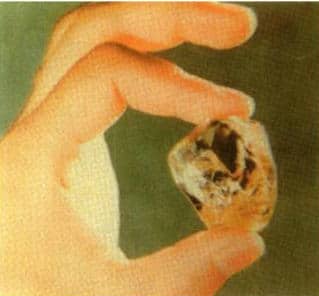
Figure 2–17 Changlin Diamond
(3) Diamond resources in Liaoning. Liaoning has both alluvial and primary diamond deposits, but the primary deposits at Wafangdian predominate. They are mainly produced in the Wafangdian area of Dalian (formerly Fuxian), around Dasi Chuan, Laotiangou, and Toudaogou. This deposit was first discovered in 1972, being one of China’s most important diamond mineral resource areas. The diamonds produced are famous for their high quality, intact crystal forms, and bright luster. The host rock of the diamonds is kimberlite; to date, 24 kimberlite pipes and nearly a hundred kimberlite dikes have been discovered, spatially clustered. Identified primary diamond deposits include Wafangdian Pipe No. 42, Laotiangou Pipe No. 30, and Toudaogou No. 51, No. 68, No. 74, No. 50 pipes, among others. The pipe-shaped kimberlite bodies have relatively complex morphologies, with surface exposures taking elliptical, bean-shaped, tongue-shaped, gourd-shaped, and irregular forms.
Based on the orebody production and distribution patterns, the Wafangdian diamond mining area can be divided from north to south into three kimberlite mineralization belts: Mineralization Belt I, Mineralization Belt II, and Mineralization Belt III.
Mineralization Belt I is located in the northern part of the mining area, extending 20 km east–west and 4 km north–south. Kimberlite development in this belt is well established and fairly continuous, with 14 kimberlite pipes distributed in total, of which Pipes 42 and 30 reach the scale of large diamond deposits. The kimberlite pipe containing diamonds in Pipe 42 is the largest, with a surface area of 41,000 square meters and proven diamond reserves exceeding 4 million carats, an average grade of 1.5ct/m3. The diamond quality is excellent: colorless series diamonds account for 50%, near-colorless and faint yellow series diamonds account for 35%, and the remainder are very light yellow series diamonds. Most diamonds are clean and flawless, with only 28% are inclusions and impurities. Most crystal forms are intact, with octahedral and rhombic dodecahedral diamonds accounting for 35% and 38% of the total, respectively. The largest discovered diamonds weigh 65.80 ct, 38.26 ct, and 37.92 ct, named Langu No. 1, No. 2, and No. 3, respectively. According to statistics, gem-quality diamonds in Wafangdian Pipe No. 50 account for 60% of the total diamonds (Fig. 2–18).

Mineralization Belt II is located in the central part of the mining area, about 15 km long east–west and about 3 km wide north–south, containing eight kimberlite pipes in total, among which Pipe No. 50 is the largest in scale.
The III ore-forming belt is located in the southern part of the mining area, about 10 km long east–west and about 2 km wide north–south, containing two kimberlite pipes of relatively low industrial value.







